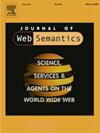在知识图嵌入中利用明确的否定陈述
IF 3.1
3区 计算机科学
Q3 COMPUTER SCIENCE, ARTIFICIAL INTELLIGENCE
引用次数: 0
摘要
知识图用于各种领域,以表示关于实体及其关系的知识。在绝大多数情况下,它们捕获了关于这些实体的已知真实内容,即积极陈述,而开放世界假设隐含地声明,图中未表达的所有内容可能是真的,也可能不是真的。这使得捕捉明确知道不真实的信息变得困难和不那么频繁,即否定陈述。此外,虽然这些负面陈述可以承担在知识图嵌入中学习更有用的表示的潜力,但这个方向很少被探索。然而,在许多领域,负面信息特别有趣,例如,在推荐系统中,用户和物品的负面关联可以帮助学习更好的用户表示,或者在生物医学领域,患者确实表现出特定症状的知识对于准确的疾病诊断至关重要。在本文中,我们认为否定语句在知识图嵌入中应该得到更多的关注。此外,我们还研究了如何在知识图嵌入方法中使用它们,强调了它们在一些有趣用例中的潜力。我们讨论了在基于步行的知识图嵌入方法中包含明确声明的否定语句的一些现有工作和初步结果。最后,我们概述了该领域未来研究的前景。本文章由计算机程序翻译,如有差异,请以英文原文为准。
Towards leveraging explicit negative statements in knowledge graph embeddings
Knowledge Graphs are used in various domains to represent knowledge about entities and their relations. In the vast majority of cases, they capture what is known to be true about those entities, i.e., positive statements, while the Open World Assumption implicitly states that everything not expressed in the graph may or may not be true. This makes it difficult and less frequent to capture information explicitly known not to be true, i.e., negative statements. Moreover, while those negative statements could bear the potential to learn more useful representations in knowledge graph embeddings, that direction has been explored only rarely. However, in many domains, negative information is particularly interesting, for example, in recommender systems, where negative associations of users and items can help in learning better user representations, or in the biomedical domain, where the knowledge that a patient does exhibit a specific symptom can be crucial for accurate disease diagnosis.
In this paper, we argue that negative statements should be given more attention in knowledge graph embeddings. Moreover, we investigate how they can be used in knowledge graph embedding methods, highlighting their potential in some interesting use cases. We discuss some existing works and preliminary results that incorporate explicitly declared negative statements in walk-based knowledge graph embedding methods. Finally, we outline promising avenues for future research in this area.
求助全文
通过发布文献求助,成功后即可免费获取论文全文。
去求助
来源期刊

Journal of Web Semantics
工程技术-计算机:人工智能
CiteScore
6.20
自引率
12.00%
发文量
22
审稿时长
14.6 weeks
期刊介绍:
The Journal of Web Semantics is an interdisciplinary journal based on research and applications of various subject areas that contribute to the development of a knowledge-intensive and intelligent service Web. These areas include: knowledge technologies, ontology, agents, databases and the semantic grid, obviously disciplines like information retrieval, language technology, human-computer interaction and knowledge discovery are of major relevance as well. All aspects of the Semantic Web development are covered. The publication of large-scale experiments and their analysis is also encouraged to clearly illustrate scenarios and methods that introduce semantics into existing Web interfaces, contents and services. The journal emphasizes the publication of papers that combine theories, methods and experiments from different subject areas in order to deliver innovative semantic methods and applications.
 求助内容:
求助内容: 应助结果提醒方式:
应助结果提醒方式:


